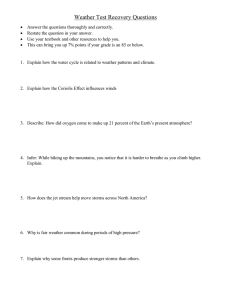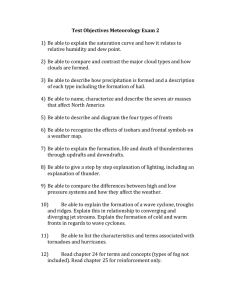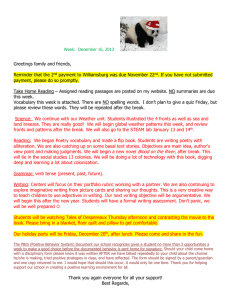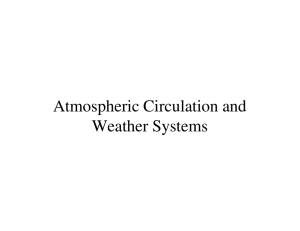Atmospheric Circulation and Weather Systems
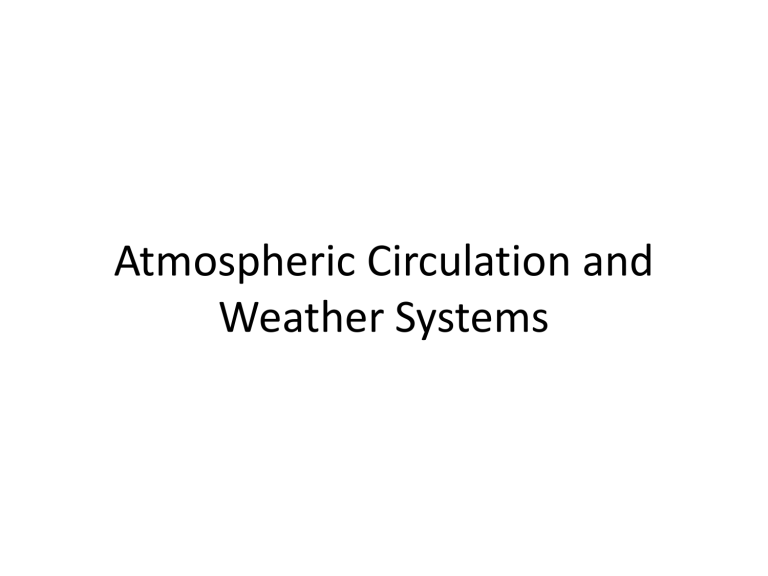
Atmospheric Circulation and
Weather Systems
Take-Away Points
1. Weather is driven by unequal solar heating and cooling
2. Air motions are affected by the Coriolis Effect and
“centrifugal” force
3. High and Low Pressure Systems
4. Air flows parallel to pressure contours (Geostrophic winds)
5. Air masses meet along sharp boundaries or fronts
6. Weather is inherently chaotic and that limits our ability to forecast it
The Seasons
Heat Lag
1. Weather is driven by unequal solar heating and cooling
Heat Lag
Atmospheric Circulation
1. Weather is driven by unequal solar heating and cooling
Atmospheric Circulation
1. Weather is driven by unequal solar heating and cooling
Asymmetric Earth
1. Weather is driven by unequal solar heating and cooling
Asymmetric Earth
1. Weather is driven by unequal solar heating and cooling
Atmospheric Circulation
1. Weather is driven by unequal solar heating and cooling
Zonal and Meridional Flow
1. Weather is driven by unequal solar heating and cooling
Semi-Permanent Features, January
1. Weather is driven by unequal solar heating and cooling
Semi-Permanent Features, July
1. Weather is driven by unequal solar heating and cooling
Rotation Effects
2. Air motions are affected by the Coriolis Effect and “centrifugal” force
The Coriolis Effect
• Due to moving on a rotating earth
• Things on equator are moving faster than points near poles
• Affects:
– Winds
– Ocean Currents
– Tides
2. Air motions are affected by the Coriolis Effect and “centrifugal” force
The Coriolis Effect
• Things moving toward the equator are deflected west
• Things moving poleward are deflected east
• Deflected to Right in
Northern Hemisphere
• Deflected to Left in
Southern Hemisphere
2. Air motions are affected by the Coriolis Effect and “centrifugal” force
The
Coriolis
Effect
2. Air motions are affected by the Coriolis Effect and “centrifugal” force
The
Coriolis
Effect
2. Air motions are affected by the Coriolis Effect and “centrifugal” force
The
Coriolis
Effect
2. Air motions are affected by the Coriolis Effect and “centrifugal” force
Inertial Circles
2. Air motions are affected by the Coriolis Effect and “centrifugal” force
“Centrifugal” Force ?
2. Air motions are affected by the Coriolis Effect and “centrifugal” force
Or No Force?
2. Air motions are affected by the Coriolis Effect and “centrifugal” force
“Centrifugal” Force Does Not Exist
• When anything turns, the only forces that act are in the direction of the turn
• These forces are called centripetal (centerseeking) force
• “Centrifugal” force is an illusion
• “Centrifugal” force is due to inertia and centripetal force opposing each other
2. Air motions are affected by the Coriolis Effect and “centrifugal” force
High Pressure Systems
3. High and Low Pressure Systems
High Pressure Systems
• Air flows out from center
• Spin clockwise in Northern Hemisphere
• No air mixing
• Stable, fair weather
• Sinking Air, few clouds
• Long duration can result in inversions, pollution
• Winter: often extreme cold
– Cold Air is Dense
– Clear Skies and Radiational Cooling
3. High and Low Pressure Systems
Low Pressure Systems
3. High and Low Pressure Systems
Why Counterclockwise?
3. High and Low Pressure Systems
Low Pressure Systems
• Air flows in toward center
• Spin counter-clockwise in Northern
Hemisphere
• Mixes air of different properties
• Associated with fronts
• Stormy, sometimes violent weather
• Passage often results in sharp change in weather conditions
3. High and Low Pressure Systems
Geostrophic Winds
• As air flows in or out of pressure cells, Coriolis
Effect deflects it
• At surface, friction limits the deflection.
– Winds blow about 45 degree angles to isobars
• Aloft, friction not a factor
– Deflection continues until limited by pressure gradient (winds can’t go against pressure)
– Winds blow parallel to contours
– This is called geostrophic flow
4. Air flows parallel to pressure contours (Geostrophic winds)
Geostrophic Flow
Geostrophic Flow
Geostrophic Flow
4. Air flows parallel to pressure contours (Geostrophic winds)
1905 Weather Map of US
First U.S. Weather Map With
Fronts
Fronts and Low Pressure Systems
5. Air masses meet along sharp boundaries or fronts
Fronts
5. Air masses meet along sharp boundaries or fronts
Warm Fronts
5. Air masses meet along sharp boundaries or fronts
Warm Fronts
• Gradual Onset
• Warm Air over Cool Air
• Little Turbulence
• Weather Rarely Violent
5. Air masses meet along sharp boundaries or fronts
Cold Fronts
5. Air masses meet along sharp boundaries or fronts
Cold Fronts
• Abrupt Onset
• Cold Air Lifting Warm Air
• Considerable Turbulence
• Weather Sometimes Violent
• Thunderstorms Common
• Can Spawn Tornadoes
5. Air masses meet along sharp boundaries or fronts
Old Low Pressure Systems
5. Air masses meet along sharp boundaries or fronts
Occluded Fronts
5. Air masses meet along sharp boundaries or fronts
Occluded Fronts
• Two fronts merge
• Any two types of front can occlude
• Most common: Cold Front overtakes Warm
Front
• Starts off like a warm front, finishes like a cold front
5. Air masses meet along sharp boundaries or fronts
Weather Prediction
5. Air masses meet along sharp boundaries or fronts
Weather Prediction
5. Air masses meet along sharp boundaries or fronts
Weather Prediction
5. Air masses meet along sharp boundaries or fronts
Chaos x
Chaos Theory
Does Not Mean:
• Cloned Dinosaurs will run amok
• Systems do not follow physical laws
• Systems behave with wild unpredictability
• Systems do not have limits
• Phenomena cannot be predicted
6. Weather is inherently chaotic and that limits our ability to forecast it
Chaos Theory
Does Mean:
• Small differences compound over time
• There are limits to how accurately phenomena can be predicted
• Examples:
– Weather
– The Planets
– Traffic
6. Weather is inherently chaotic and that limits our ability to forecast it
